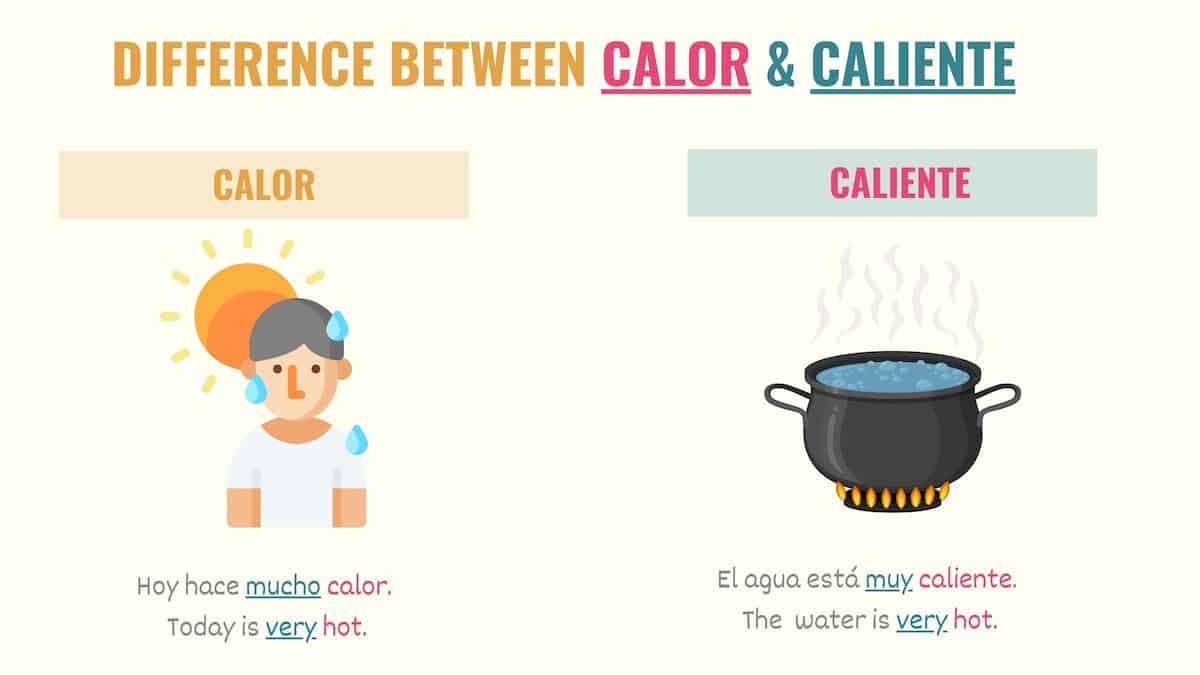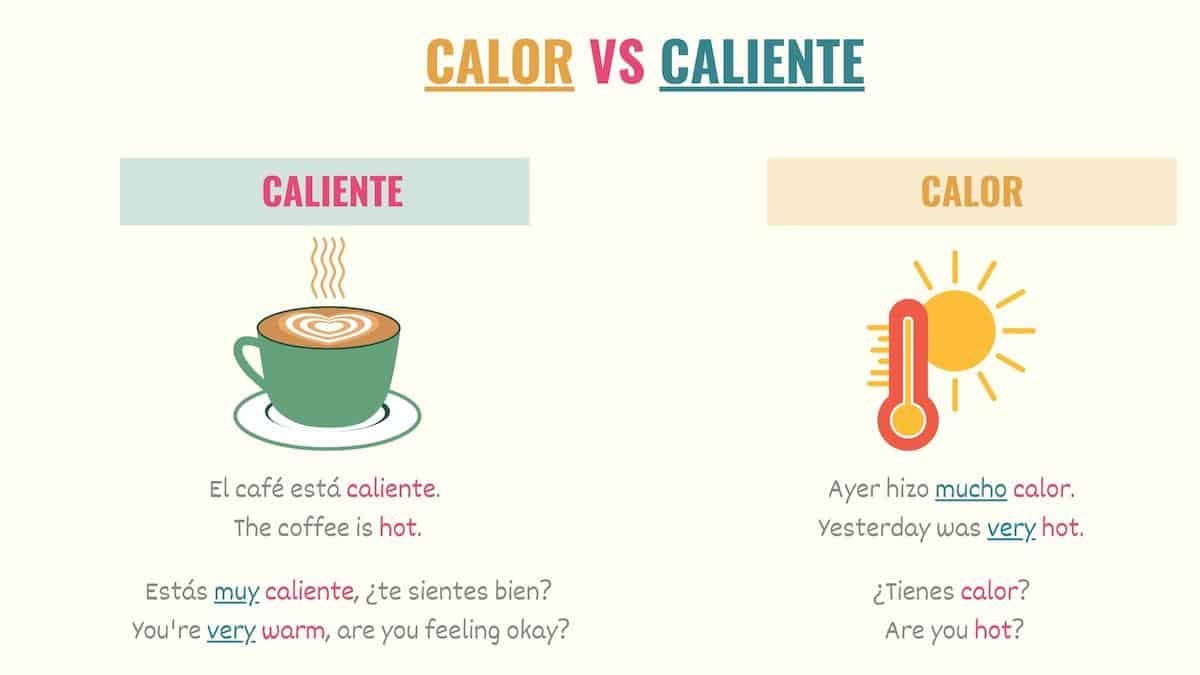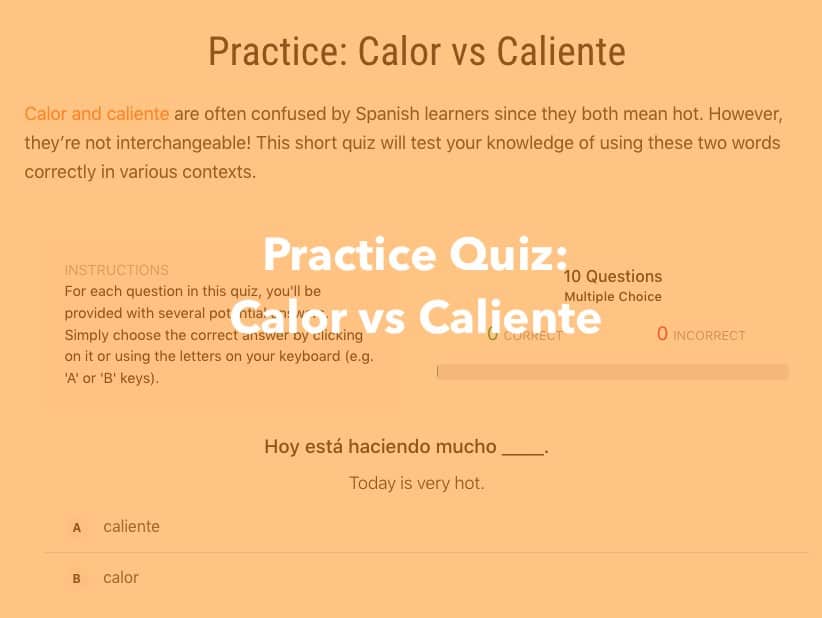‘Hot’ in Spanish is either calor or caliente. But even though they are both related to temperature, these terms are not synonyms. As a result, many people wonder what’s the difference between ‘calor’ and ‘caliente’ in Spanish.
Calor and caliente mean ‘hot’ in Spanish. However, caliente is an adjective that describes something or someone’s temperature. It can be translated as ‘hot’ or ‘warm’. Calor is a noun that talks about the weather and the physical feelings it causes on people. So, ‘calor’ means ‘hot’, ‘to be hot’ or ‘heat’.

Since in many contexts, ‘calor’ and ‘caliente’ can be translated as ‘hot’, Spanish learners often struggle to understand when to apply these words correctly. For that reason, the following sections will dig deeper into the difference between these words.
- Difference between calor and caliente
- What does Calor mean in Spanish?
- How & When to use Caliente
- Wrapping Up & Key Points
- Practice Quiz: ‘Calor’ vs ‘Caliente’
- Download Cheat Sheets
I’ll provide you with tips, sentence structures, and real-life examples to give you a better understanding of when to use each one of these words. By the end of it, you’ll know the difference between ‘calor’ and caliente’.
What’s the Difference Between Calor and Caliente in Spanish?
As established before, calor is a noun that we use to talk about the weather or temperature. This word also allows you to express that a person feels warm due to the weather. So, ‘calor’ is the Spanish equivalent of ‘hot’, ‘heat’ or ‘warm’. ‘
En México, el calor es muy fuerte en verano.
In Mexico, the heat is quite strong in the summertime.
¿Vamos por un helado? ¡Tengo muchísimo calor!
Should we go for ice cream? I’m very hot!
No manches, ¡qué calor hace!
Geez, it’s so warm today!
On the other hand, caliente is an adjective. This means that we use this word to describe an object’s or person’s temperature. In Spanish, ‘caliente’ can mean either ‘hot’ or ‘warm’. Since temperature is a temporary characteristic, ‘caliente’ works with the verb ‘estar’.
Susy, ¡vamos al doctor! ¡Estás muy caliente!
Susy, let’s go to the doctor! You’re very warm!
Toma tu café, ten cuidado, está muy caliente.
Here is your coffee, be careful, it’s very hot.

Now that you’ve learned the key differences between these words, it’s time to see the contexts and the elements you need to know in order to use them correctly.
What Does ‘Calor’ Mean in Spanish
In Spanish, ‘calor’ is a masculine noun that we use to talk about the weather or the physical feeling that a person experiences when it’s exposed to the sun or high-temperatures. So, depending on how it’s used, ‘calor’ can have different translations:
- Calor means heat or hot when talking about high temperatures related to the weather.
- Calor means warm when people talk about the physical feeling that high temperatures cause them.
- Calor means warmth when describing the energy or sensation that something hot emits.
Here are some examples of how to apply this word in these situations:
[Definite article] + calor
Me gusta más el frío que el calor.
I like the cold more than the heat.
El calor está muy intenso el día de hoy.
The heat is very intense today.
Me gusta ir a la playa y disfrutar del calor.
I like going to the beach and enjoying the warmth.
Gracias a las lluvias, el calor ha ido disminuyendo.
Thanks to the rain, the heat has been decreasing.
If instead, you want to use calor to describe the weather you can use the following structure. Notice that ‘hacer’ can be conjugated to any tense as long as you use the third-singular person. You can also use adjectives to explain how hot the weather is.
Hace + (adjective) + calor
Oye, María, ¿en Colombia hace mucho calor?
Hey, Maria, is it too hot in Colombia?
Lleva ropa más ligera. En México siempre hace calor.
Take lighter clothes. In Mexico, it’s always hot.
No dormí bien porque hizo bastante calor en la noche.
I didn’t sleep well because it was quite hot last night.
Finally, here is the structure that you need to follow when using ‘calor’ to talk about the physical feeling that the weather is causing you or someone else. In this context, you’ll use it with the verb ‘tener’.
[Tener conjugated] + (adjective) + calor
¡Qué clima tan horrible! Tengo mucho calor.
The weather is awful! I’m very hot.
¿Tienes calor? ¿Por qué no vamos por un helado?
Are you warm? Why don’t we go for an ice cream?
Maestra, ¿podemos prender el aire acondicionado? Tenemos mucho calor.
Professor, can we turn the air conditioner on? We’re very hot.
How & When to Use Caliente in Spanish
In Spanish, ‘caliente’ is an adjective that allows us to describe an object’s or a person’s temperature. As a result, this word means ‘hot’ or ‘warm’.
Here are some examples of how to use this word. Notice that if you want to mention how hot the object is, you’ll need to use adverbs:
[‘Estar’ conjugated] + (adverb) + caliente
¡Abre las ventanas! ¡Está muy caliente aquí adentro!
Open the windows! It’s very hot in here!
¿Te quemaste? ¡Te dije que el agua estaba caliente!
Did you burn yourself? I told you the water was hot!
Me voy a esperar un poco, mi taza todavía está muy caliente.
I’m going to wait a little bit, my cup is still very hot.
Tu hermano está muy caliente, creo que tiene temperatura.
Your brother is very warm, I think he has a fever.
¿Tienen hielo? El café está muy caliente, no me lo puedo tomar.
Do you guys have ice? The coffee is too hot, I can’t drink it.
Since all Spanish adjectives that end with an ‘e’ don’t have a feminine form, you’ll use caliente to describe both masculine and feminine objects.
Related Resource: How to Use Estar in Spanish
She’s hot / He’s hot
Although ‘caliente’ is the direct translation of ‘hot’, in Spanish, we don’t use this word when talking about attractive people. For this situation, ‘hot’ can be translated as ‘atractiva/atractivo’ or ‘bueno/buena’.
La chica nueva es muy atractiva. The new girl is very hot.
¡Qué bueno está el novio de Olga! Olga’s boyfriend is so hot!
Related Resource: How to Call a Man Handsome in Spanish
Take Note: When referring to people, caliente is not a bad word. But, as established above, it’s not used to express that someone is attractive. If used to talk about people, ‘caliente’ means ‘aroused’. So as cool as it sounds, you may not want to use muy caliente when referring to a friend.
Wrapping Up & Key Points
‘Caliente’ and ‘calor’ are two Spanish words that can be easily confused by Spanish learners. Since confusing these words will have a negative impact on your fluency, in this article, we discussed the differences between them. Here are some key points to keep in mind:
Caliente
- It’s an adjective.
- Describes an object’s or person’s temperature.
- Works with the verb ‘estar’.
- It means ‘hot’ or ‘warm’.
Calor
- It’s a noun.
- Describes the weather using the verb ‘hacer’. It means ‘hot’, ‘heat’ or ‘warm’.
- When working with the verb ‘tener’, ‘calor’ describes the physical feeling that a person experiences due to the heat. It means ‘hot’ or ‘warm’.
Now that you have a better understanding of these words, you’re ready to start applying them in the correct context.
Watch the Spanish Immersion Lesson
All Tell Me In Spanish are recorded in English and Spanish so you can learn new concepts regardless of your comprehension level.
Click this video to watch the immersion lesson on Calor vs Caliente: how to ‘hot’ in Spanish.
Practice Quiz: Calor vs Caliente
Solidify your knowledge of ‘hot’ in Spanish by taking this multiple choice quiz on using calor vs caliente!

Download the ‘Calor’ & ‘Caliente’ Cheat Sheets
Feel free to download the PDF of the graphics and resources included in this article to study later!



